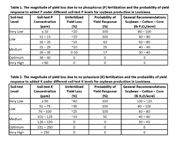Phosphorus And Potassium Fertilization Decision In 2022
RASEL PARVEJ
BATON ROUGE, LOUISIANA
Phosphorus (P) and potassium (K) fertilizer recommendations depend on Mehlich-3 soil-test P and K concentrations, respectively from soil sample taken from 0- to 6-inch depth in Louisiana. Fertilization is recommended if soil-test nutrient concentrations fall below the critical level. The critical nutrient level is defined as the range of soil-test nutrient concentration below which crop response to added fertilizer is expected, within which is uncertain, and above which is unlikely. The current LSU AgCenter soil-test-based P recommendations for major row crops (corn, soybean, and cotton) is very straight forward, which offer only one range of critical P concentration (21 to 35 ppm P or 41 to 70 lb/acre P) for all soil types. However, the soil- test-based K recommendations vary with soil types and soil formation processes and provide 8 to 10 different critical K concentrations across different soil types and geographical locations (e.g., 98 to 141 ppm K for silt loam, 142 to 264 ppm K for clay loam, 142 to 317 ppm K for silty clay soils, and so on). Note that most states have only one critical concentration of a particular nutrient for each row crop. Even some states have only one critical concentration of a particular nutrient for all row crops. Considering these facts, we reevaluated our current P and K recommendations for soybean production in Louisiana across 32 sites with different soil types that ranged from very fine sandy loam to clay from 2020 to 2021. This study will be continued at another 15-20 sites in 2022.
Based on our 2-yr study, we found that regardless of soil types, soybean in soils with less than 15 ppm P at 0- to 6-inch depth always (100 percent) responded positively to added fertilizer-P, 63 percent of the time for soil-P concentration between 15 and 20 ppm, 25 percent of the time for soil-P concentration between 21 and 25 ppm, and responded very seldom when soil-P concentration was more than 25 ppm (Table 1). However, for K fertilization, soybean in soils with less than 101 ppm K always (100 percent) responded positively to fertilizer- K and never (0 percent) responded when soil-K concentration was more than 101 ppm regardless of soil types (Table 2). Our results suggest that we need to revise our current P and K recommendations and it may be possible to develop only one single critical K concentration range across all soil types. It also suggests that we must fertilize our soybean fields with soil-test P concentration less than 15 ppm P and soil-test K concentration less than 101 ppm K. Without fertilization soybean yield in these soils can be reduced up to 20 percent due to no P fertilization, 40 percent due to K fertilization, and even greater amount if no P and K fertilizers are provided. Although our research was conducted on soybean, this result can also be interpreted fairly well in making fertilization decision for corn and cotton production in Louisiana.
Considering the record high fertilizer price this time of the year, producers may not need to provide all the recommended rates (roughly 60 to 80 lb P2O5/acre and 80 to 100 lb K2O/acre, Table 1 and 2) but at least some amounts that they can afford to produce near maximum yield and still be in business. For example, depending on how deficient the soil is, producers can still produce profitable crops by applying around 50-80 percent of the recommended rates. Note that the lower the soil-test P and K values the higher the chances are for getting return on investment for fertilization. No P and K fertilization would be economically sound for soils with higher than 20 ppm (40 lb/acre) P and 120 ppm (240 lb/acre) K for corn, soybean, and cotton production across all soil types in 2022. Overall, soil-testing is very important in making fertilization decision, and producers should invest little more money on soil-testing rather than fertilizing their field without knowing the magnitude of yield response to added fertilizers. In addition, producers need to interpret the actual soil-test values (ppm or lb/acre) rather than soil-test level/index (low, medium) in making fertilization decision since the interpretation of soil-test level varies with soil testing labs. ∆
Rasel Parvej, David Moseley, Syam Dodla, and Rezaul Karim: Louisiana State University AgCenter Scientists
